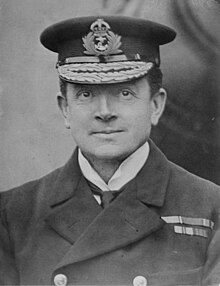Somerset Gough-Calthorpe
Sir Somerset Arthur Gough-Calthorpe GCB , GCMG , CVO (born December 23, 1864 in London , † July 27, 1937 in Ryde ), also known as Sir Somerset Calthorpe , was an Admiral of the Fleet in the Royal Navy .
Life
Calthorpe was born into a noble family, his father became the 7th Baron Calthorpe in 1910. He spent part of his childhood in France. In 1878 he came as a cadet on the training ship HMS Britannia and in 1880 was assigned as a midshipman to the armored cruiser HMS Northampton , which served as the flagship of the North America and West Indies station . In 1886 he was promoted to lieutenant and came on the tower ship HMS Colossus with the Mediterranean Fleet . After attending the HMS Vernon torpedo school , he was assigned to the training staff in 1890. From 1891 to 1893 he served as a torpedo specialist in the British possessions of Hong Kong . At the end of 1894 he came on the new cruiser HMS St George , which served on the Cape of Good Hope Station and West Africa Station , and took part in the 4th Ashanti War during this time .
Promoted to commander in January 1896 , he took command of the armored cruiser HMS Imperieuse , the flagship of Pacific Station . After his return to the mother country in 1899, he married a Canadian in 1900 and became the commandant of the large torpedo boat HMS Halcyon in the Mediterranean fleet. Promoted to captain in 1902 , Calthorpe served for the next three years as a naval attaché for Russia, Sweden and Norway. In 1905 he received command of the armored cruiser HMS Roxburgh in the Channel Fleet , and later of the pre-dreadnought battleship HMS Hindustan . From 1909 he served under William May as captain of the Home Fleet on board the HMS Dreadnought . In 1910 he changed his last name to Gough-Calthorpe .
Promoted to Rear Admiral in 1911 , he became Deputy Commander of the 1st Battle Squadron with the flagship HMS St Vincent in 1912 . In the summer of 1914 he took command of the 2nd Cruiser Squadron with the flagship HMS Shannon , which was formed in the Grand Fleet with the outbreak of World War I. In March 1915 he was appointed temporary vice admiral . On the New Year of 1916 he was awarded the KCB . From July to December 1916 he served as the Admiralty's Second Sea Lord . He was then transferred to the command of the reserve fleet by the new incumbents First Lord of the Admiralty Sir Edward Carson and First Sea Lord Sir John Jellicoe.
After his rank as Vice Admiral had been confirmed in April 1917, Gough-Calthorpe was given command of the Mediterranean Fleet in July 1917, succeeding Sir Rosslyn Wemyss , who was ordered back by the new First Lord Eric Campbell Geddes . In this role he negotiated the Mudros armistice with the Ottoman Empire at the end of October 1918 .
In the post-war period Gough-Calthorpe served as British Commissioner in the Ottoman Empire from 1918 to 1919, and then as Commander-in-Chief in Portsmouth until 1923. From 1924 he served as the King's First and Principal Naval Aide-de-Camp . In 1925 he was promoted to Admiral of the Fleet and took his leave in 1930.
literature
- TA Heathcote: British Admirals of the Fleet, 1734-1995. Pen & Sword, 2002, pp. 103-105.
| predecessor | Office | successor |
|---|---|---|
| Sir Frederick Hamilton |
Second Sea Lord 1916 |
Sir Cecil Burney |
| Item created again | Commander-in-chief of the Mediterranean Fleet 1917–1919 |
Sir John de Robeck |
| - |
British High Commissioner in Constantinople 1918–1919 |
Sir John de Robeck |
| Sir Cecil Burney | Commander-in-Chief, Portsmouth 1920-1923 |
Sir Sydney Fremantle |
| personal data | |
|---|---|
| SURNAME | Gough-Calthorpe, Somerset |
| ALTERNATIVE NAMES | Gough-Calthorpe, Sir Somerset Arthur; Calthorpe, Sir Somerset |
| BRIEF DESCRIPTION | British Admiral of the Royal British Navy |
| DATE OF BIRTH | December 23, 1864 |
| PLACE OF BIRTH | London |
| DATE OF DEATH | July 27, 1937 |
| Place of death | Ryde |
